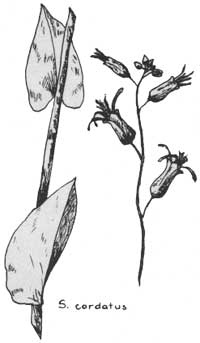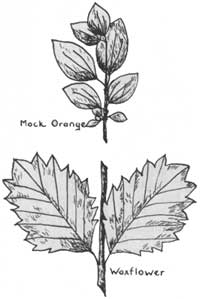|
ZION
Plants of Zion National Park |

|
Zion-Bryce Museum Bulletin
Number 1
PLANTS OF ZION NATIONAL PARK
Families of Plants
(continued)
POPPY FAMILY (PAPAVERACEAE)
Plants with showy flowers and watery, milky, or colored juice. The most common one in our area is the THISTLE POPPY, Argemone hispida. (Plate IV). It has a wide zonal distribution and may be found in open, sandy places throughout the park. Its large white flowers are especially noticeable along the Mt. Carmel Highway in July.
In Coalpits Wash there are two relatives of the California Poppy, resembling it very closely except that the yellow flowers are much smaller. They are Eschscholtzia glyptosperma, and Eschscholtzia minutiflora. Both bloom in late April and May.
FUMITORY FAMILY (FUMARIACEAE)
This family, to which belongs the familiar Bleeding Heart, is represented in Zion by only one species, Capnoides montanum, sometimes called GOLDEN SMOKE. It is a low, semi-creeping plant with smoky-green finely divided foliage, and loose clusters of small but conspicuous yellow irregular flowers, each one having a long spur. It can be found blooming along the trails in Zion Canyon from April to early June.
MUSTARD FAMILY (BRASSIOACEAE)
Many of the common flowering plants of Zion belong to this family, which is distinguished by alternate leaves and terminal clusters of flowers with 4 petals spreading to form a cross.
PRINCE'S PLUME, Stanleya arcuata, is very conspicuous in the Sonoran Zones during May and June, when it sends up tall spikes of lemon yellow flowers above the low chaparral along roadsides and trails.
Thelypodium integrifolium, sometimes called White Mustard, is a tall weedy plant found above 4000 feet, usually in deep, rich soil. (Plate V). Thelypodium lasiophyllum has smaller flower clusters, wider slightly notched leaves, and usually grows in rocky soil below 7000 feet, as does also Thelypodium wrightii, a narrow-leaved form that has been collected in Coalpits Wash.

Another plant often known as WHITE MUSTARD is Streptanthus longirostris, a much-branched annual with small narrow leaves and small clusters of white flowers at the end of the branches. It is very common along the Narrows Trail, and others in Zion; blooming in June. Streptanthus cordatus has a different appearance — a single stout stalk, often 2 feet in length, with small but striking flowers, yellowish-green to purple, blooming in June and early July. It is common on chaparral slopes of the Upper Sonoran Zone, as at the lower end of the West Rim Trail.
We have three kinds of PEPPER-GRASS, recognized by their numerous spikes of small, green, disc-shaped seed pods. Lepidium eastwoodiae, and L. densiflorum, are found chiefly in the Upper Sonoran Zone; Lepidium georginum is confined to lower altitudes, as in Coalpits Wash.
PENNYCRESS, Thlaspi coloradense. A very small white "mustard" not over 4 inches high, found growing in sand-filled crevices in the rock cliffs and slopes along Mt. Carmel Highway.
In the lower part of Zion Canyon, farmed previous to 1930, there are two introduced species belonging to the same genus as the cabbage, turnip, etc,: Brassica campestris, or RUTABAGA; and Brassica juncea. Another introduced genus is represented here by Malcolmia africana.
WATERCRESS, Sisymbrium nasturtium-aquaticum. This well-known water plant, originally introduced from Europe and now found throughout temperate North America, grows in all the springs and brooks in the park.
BITTERCRESS, Cardamine pennsylvanica, has been collected near the south boundary, at the stone quarry.
TWINPOD, Physaria didymocarpa. An odd-looking hairy perennial about six inches high with pairs of inflated papery seed pods the size of small marbles. Dry places above 4000 feet. Below that altitude Physaria newberryi is found.
WHITLOWGRASS is distinguished by the short flat pods borne in dames spikes which rise 4 to 12 inches above clumps of small basal leaves. Draba asprella, D. montana, and D. micrantha, are the three kinds known to be in Zion.
TANSY MUSTARD, Sophia sonnei, is a branching "weed" with finely divided leaves and several spikes of closely spaced, small, oval seed pods on delicate stems. It is common in the lower part of Zion Canyon and Coalpits Wash.
ROCKCRESS, Arabis perennans, has been collected at the south entrance.
There are two kinds of WALLFLOWER in Zion, The bright yellow flowers, larger than most other mustards, (2 to 3 feet) make them among the most attractive of this family. Cheirinia aspera, and C. elata, are our two kinds found throughout the park, usually on rather dry slopes. (Plate V). They can be distinguished by the slightly toothed leaves on the latter.
CAPER FAMILY (CAPPARIDACEAE)
This family is somewhat like the mustard family. It is represented in Zion by two kinds of BEE-FLOWER: Cleome lutea, the common yellow-flowered kind; and Cleome surrulata angusta, the purple-flowered ROCKY MOUNTAIN BEE-FLOWER, which is very common along Highway 89, but uncommon in the park near the east entrance. Both are very conspicuous roadside flowers in June and July, and are important sources of honey.
STONECROP FAMILY (CRASSULACEAE)
Small plants with smooth fleshy leaves adapted to storing water, They are not common in Zion, but among the rocks in the cooler canyons two kinds have been collected: Sedum leibergii, less than four inches tall; and Sedum stenopetalum, about 6 inches high, with more conspicuous flowers. Both species have yellow blossoms, in June.
SAXIFRAGE FAMILY (SAXIFRAGACEAE)
The members of this family that occur in Zion can be recognized by the nearly leafless flower stalk rising from a basal cluster of round scalloped leaves. ALUM ROOT usually grows in crevices in the rocks; the two kinds in the park are Heuchera leptomeria, and H. lithophila, both growing on canyon sides from 4500 feet altitude upward. WOODLAND STAR, Lithophragma bulbifera, more delicate in appearance than alum root, grows among rocks on the plateaus.
PARNASSIA FAMILY (PARNASSIACEAE)
Represented here only by GRASS OF PARNASSUS, Parnassia parviflora, to be found blooming in August in very wet places on Horse Pasture Plateau. It is a delicate plant with white flowers at the top of slender stalks about 4 inches high, with a basal cluster of small heart-shaped leaves. It is sometimes mistaken for a white buttercup.

HYDRANGIA FAMILY (HYDRANGEADEAE)
A family of shrubs having opposite leaves, and flowers somewhat like those of the saxifrage family. The three species found in Zion are confined to the cool canyons.
MOCK ORANGE is a small shrub, 3 to 4 feet high, with slender branches, small oval leaves, and small white flowers; found in almost any of the canyons, but not common. The two kinds are difficult to distinguish; the leaves of Philadelphus microphyllus are usually smooth on the upper surfaces; those of P. occidentalis are slightly hairy on both sides.
WAX FLOWER or CLIFFBUSH, Edwinia americana, grows in rock crevices, beautifying them with its clusters Mock Orange of white waxy flowers during June and early July. The toothed leaves are gray-green beneath.
GOOSEBERRY FAMILY (GROSSULARIACEAE)
This well-known family is here represented only by the GOOSEBERRY CURRANT, Ribes montigenum, one of the few currants having spines. It is rather rare in the park, in the coolest parts of Horse Pasture Plateau. The berries are red, with small bristles.